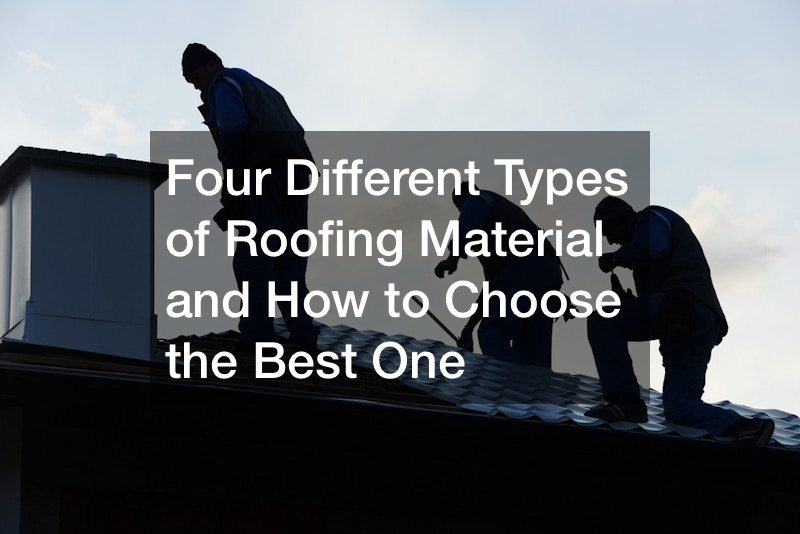
When it comes to roofing materials, you should not just decide based on price, looks, etc. You should find a local roofing expert who is familiar with your climate and will recommend the best materials for your area. Whether you are looking for metal roofing materials, asphalt shingles, wooden shakes, green roofing, slate, or clay tile, you should inquire about the best options that will last you a lifetime.
Though there are many types of roofing materials on the market, the four we will discuss are energy efficient metal roofing, asphalt, wooden, and green roofing. Though they are all solid options, we hope you do your homework to decide what materials work best for you.
From there, you also want to consider the warranty options for each type of roof. For instance, the steel roof life expectancy is much longer than that of an asphalt shingle, so the warranty is typically longer. Another example is that if you live in an area with high winds, the metal roof wind rating can be much greater than that of wood shingles.
Still, you should talk to your local roofing experts about maintenance concerns with each available material you are considering. The best metal roofing material on the market may require less maintenance than green roofing options. Still, you should do your due diligence and ensure you get the best roofing materials for your hard-earned money.
When it comes to roofing, local roofers are the best people to approach. They’re more accessible and would offer personalized service. They’re aware of local building codes and know what roofing material is suited to the local climate.
How to fix a garage roof? If there’s a leak, inspect the roof and assess the damage. Seal cracks and holes using a sealant or roofing cement. Replace any damaged shingles and clean the roof. You should hire a professional roofer as DIY repair jobs can be dangerous. Search online for ‘repair my garage roof’. Look at the reviews before hiring any companies.

Roofs have a lifespan, and you should know the difference between roof restoration vs replacement. Once a roof has reached the end of its lifespan, it should be replaced entirely. A roof replacement is also done when it’s severely damaged. Roof restoration involves cleaning it, carrying out repairs, replacing damaged shingles, and applying sealant to any cracks.
Roof remedies depend on the specific problem. Moss should be removed with a special cleaner, cracks should be sealed with a roofing sealant, and gutters and drains should be cleaned to avoid water accumulating.
Roofs should be cleaned and maintained once a year at the very least. Maintaining your roof can help to extend its life and safeguard your home.

There are currently 75 million single-family homes in the United States, according to Bill Hippard, president of the Metal Roofing Alliance. And of those 75 million homes, about 7% re-roof annually, which comes out to about 5 million new roofs per year. Replenishing a roof is great for the health (and the value) of a home, but how does a homeowner even begin to understand which materials are best to work with?
One option is to start doing some heavy research. Whether you’re installing an outdoor patio, planning enough space for a screened-in porch or deciding on a cultured stone fireplace, the more background info you know about your desired home improvement task, the better you’ll be able to make the right choice.
But let’s get back to roofing. You’re going to want to be familiar with the most popular and modern styles, so here’s a little cheat sheet you can use to help jumpstart your research.
Option 1: Asphalt Shingles
The Appeal: TheHouseDesigners.com reports that nearly three-quarters of all American homes have asphalt shingles because of their neutral appearance, which gives them a bit of a universal appeal. The downside, however, is a much shorter lifespan than other materials in addition to poor insulating quality.
The Cost: Typically around $50 to $150 per square, though that all changes based on where you choose to buy the materials. There’s also an environmental cost — or more appropriately, asphalt shingles aren’t very “green,” especially compared to…
Option 2: Wood Shingles
The Appeal: If asphalt is neutral, wood is strikingly rustic and quite a bit more natural on its appearance. All things considered, this one really comes down to aesthetics, and wood often gives a home a much warmer quality than most other materials can. Think of them as the cultured stone of roofing materials.
The Cost: TheHouseDesigners.com calls wood shingles “high maintenance” because of how they crack and rot, just as regular wood does. They’re made of all-natural materials though, which is a selling point, though it ups the price to over $100 per square.
Option 3: Steel, Aluminum and Copper
The Appeal: Metal roofs in general are extremely energy efficient and make for a suitable green option for any home. Plus, their sleek appearance gives your home in a very modern, very contemporary and extremely unique — especially when put up against all the others in suburbia.
The Cost: Depends on what type, but the low end runs about $100 per square and the pricier stuff (stained copper and the like) can reach up to $600.
Option 4: Green Roofing
The Appeal: When you want an environmentally friendly option, you really can’t much greener than actual grass. Yes, green roofing is effectively a garden right atop your home growing either large plants or small coverings of moss. They’re great for drainage, too.
The Cost: Surprisingly, green roofing is only about $15 or $20 per square foot. Plus, you may get some financial benefits back in the form of a higher resale value for your home.
Though cultured stone fireplaces make your home more luxurious, updating roofing can prove to be a significantly wiser financial decision. Just ask any professional roofing service. More on this topic.


